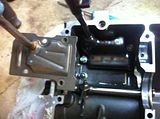Here are some design changes for those interested in knowing. To start, here some numbers of the two to put things in perspective.
Ninja 250
Compression ratio 11.6:1
Bore and stroke 62.0 x 41.2mm
oil capacity 1.7L (1.8 qt)
Ninja 300
Compression Ratio 10.6:1
Bore and Stroke 62.0 x 49.0mm
oil capacity 2.4L (2.5 qt)
Now onto the comparision!
CYLINDER HEAD
The 300 intake port ID is ~30 mm vs ~27.5 mm. From there on after it funnels down. OD is the same so boots will interchange if you wanted to use carbs or fuel injection. All other parts are the same. Exhaust ports sizes are the same between the two: ~27 mm ID. Exhaust headers interchange depending on clearance of oil filter on the 300.
Another interesting thing I found is the intake valve is larger on the 300.
*disclaimer: my digital caliper is not the best*
visual comparison
300 intake valve
250 intake valve
250 exhaust valve
300 exhaust valve
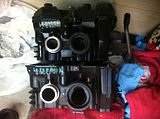
250 and 300 intake boots:
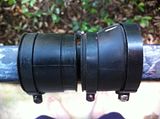
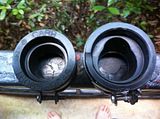
300 boots have a lip and do not have a smooth transition into the intake port like the 250. Remove the lip with an exacto knife may help intake performance.
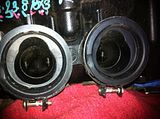
300 throttle body boot on 250 head. You can notice the smaller ID of intake port.
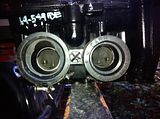 HEAD GASKET
HEAD GASKET
EDITED:
Which head gasket can you use?
ORIGNAL:
Quote:
You can use a 250 gasket on the 300 cylinder head. You will leak coolant near the cam chain area. Here's a 250 gasket on top of the 300 cylinder block.
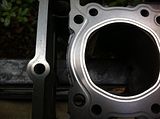
|
CYLINDER BLOCK
The 250 cylinder block contains steel cylinder sleeves pressed into an aluminum block whereas the 300 block is lighter and full aluminum cast with nikasil plated cylinders. The 300 cooling jacket is entirely whereas the 250's is enclosed. The back coolant port is square on the 300 and round on the 250. Height of the cylinders and block are the same between the two models. I am not sure why there is a notch connecting the two cylinders on the 300 yet. Cam chain tensioners are the same.
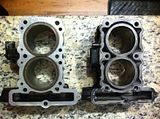
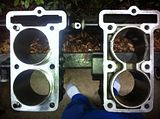
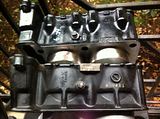
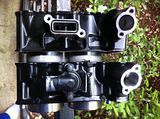
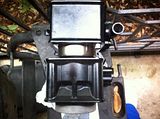 CYLINDER BASE GASKET
CYLINDER BASE GASKET
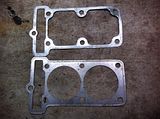
You can see where the 300 is larger on the inside of the cam chain area. The 300 block is bigger in this area to accommodate its cooling jacket.
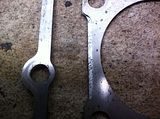 PISTONS
PISTONS
The late model 250 pistons are crowned and the 300 pistons are flat tops. 250 pistons have oiling holes for the pistons pins and the 300 lacks it. Also noted is that the 250 pistons have holes casted under the piston. Perhaps for weight reduction and to reduce windage. Each piston has 8 oil drain back holes in the oil ringland groove.
300:
piston deck to skirt bottom length: 41.8mm
top of pin bore to deck: 13mm
skirt width: 38mm
250:
piston deck to skirt bottom length: 47mm
top of pin bore to deck: 14mm
top of pin to top of dome: 16.5mm
skirt width: 38mm
Left: 250 Right: 300
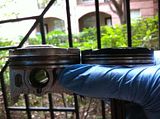
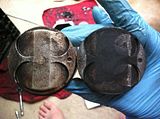
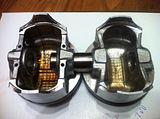
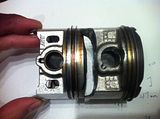 RODS
RODS
250 rods are about 2.8mm longer than the 300 rods. The 250 rod oiling holes are not chamfered like the 300's. The 300 rod piston ends are thicker.
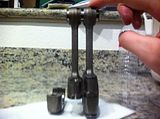
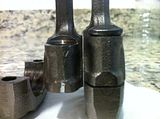

 CRANKSHAFT
CRANKSHAFT
If you didn't know by now already, the 300 crankshaft is a "stroked" version of 250 and yes, they interchange without any clearance issues. The 300 rod journal is placed 3.9 mm farther from centerline giving it the increased stroke. Aside from that, the only difference you'll see between the two are the weight shapes.
Left: 300 Right: 250. The 300 crank has the flywheel bolt attached still.
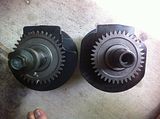
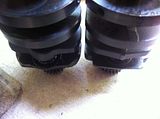

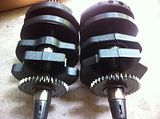

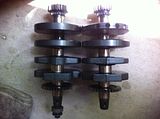 COUNTER BALANCER
COUNTER BALANCER
The purpose of the counter balancer is to reduce engine vibrations. The 300 has heavier weights as seen by the thickness. The oiling holes are 90 degrees off from the 250 but it's nothing significant.
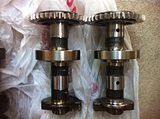 LUBRICATION SYSTEM
a. Oil filter
LUBRICATION SYSTEM
a. Oil filter
The late model 250 oiling system is very outdated and not much had changed from the early model 250s. The oil filter is an open element encased in a separate compartment within the lower crankcase. The bolt that holds it place contains a pressure relief valve that opens when the filter media is clogged to keep oil pressure up to maintain bearing life but spews out contaminated oil at the same time. The oil filter media surface area is maybe 1.25+ times larger than on the 300 can filter. Installing a larger oil filter on the 300 increases oil and filtering capacity. A little more work is involved in changing the oil filter on the 250 vs the 300.
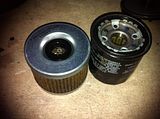

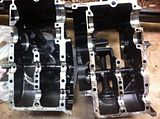
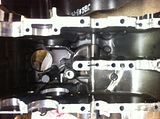
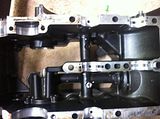
Inside the lower bottom of the crankcase on the 250 there are numerous spots for large deposits of crud to pool. The oil in the motor is
pre-screened before it is sucked up into the oil filter where it catches the finer particles. The metal pre screen catches all the big debris but not all of it will accumulate there. Granted, if you have big stuff there you have bigger problems to worry about. There is a plastic oil pick-up tube with a metal screen snapped inside.
Advantages of the 300 oil pan:
1. increased oil capacity
2. increased oil cooling efficiency due to the extra surface area of cooling fins
3. baffled oil pan prevents oil from sloshing around
4. no places for unfiltered crud to pool
5. access to the lower crankcase assembly without having to split the case

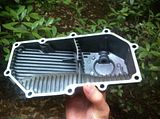
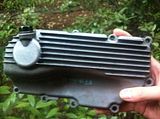 b. Oil Pump
b. Oil Pump
The oil pump on the 250 is a separate and removable unit. It is bulky and heavy. The 300 oil pump is built into the lower crankcase. The crankshaft drive gear is lighter due to the holes cut into it which reduces rotating mass. The oil pump gears are the exact same between the two.

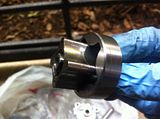
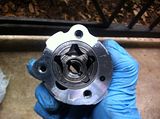
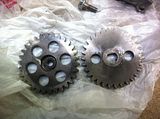
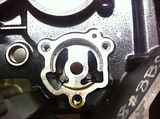
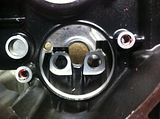
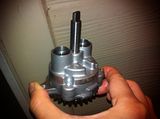
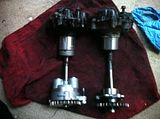 c. piston oil squirters
c. piston oil squirters
The 250 only has what looks like one oil squirter drilled for the right piston and none for the left. The 300 has 2 tapped into one of the main oil galleys similar to the 250 in location but for both pistons. Oil is used for lubrication as well as cooling.
250:
You can see the small hole in the metal shaft towards the middle right.
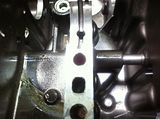
300:
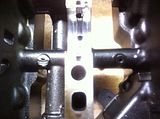
(the left squirter is slightly damage from motor throwing a rod)
d. oil pressure valve release
250: located on the left side under the crank cam chain gear. 300: located on the underside of the lower crankcase across from the oil pickup filter.

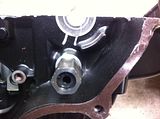

Also note the cast-in lip on for the crankshaft cam chain guide differences. The lip on the 300 is further away and rounder to help keep the cam chain oiled better. I was experiencing came chain slapping against the lip on the 250 which cut a groove in the lip.
CRANKCASE BREATHER
The 250 vents from the lower case via pipe and also looks like up top too from a hole while the 300 just vents from via pipe from the lower case.
